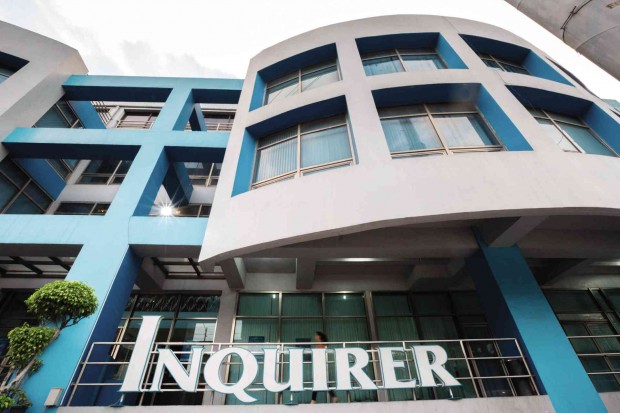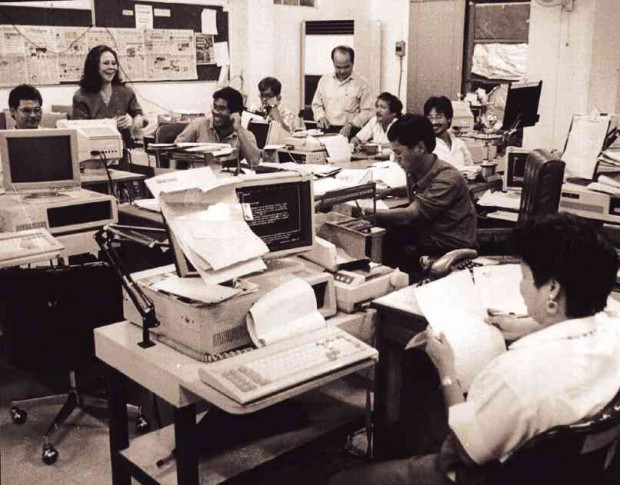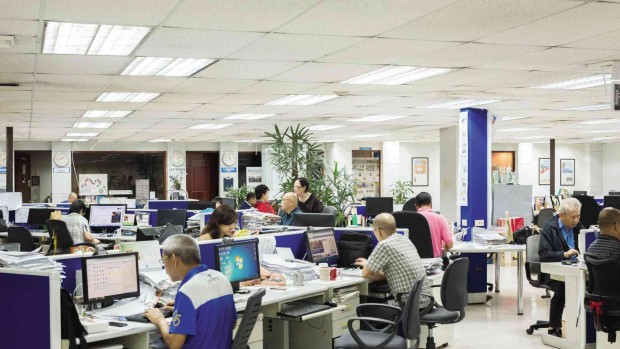Courageously telling the Filipino story anytime, anywhere
BY 2016, The Inquirer will have an integrated newsroom to house all its news platforms—print, online, social, mobile, radio—in its main office on Chino Roces Avenue in Makati City.
The big news comes from Inquirer Chair Marixi Rufino Prieto, whose family has been the Inquirer’s steward for more than 20 years, leading its growth from one newspaper to 10 companies so far.
“This shows (the Inquirer’s) deep commitment to serve our readers and viewers. We want to be able to strengthen each touchpoint to give them the content they want in the way they want it,” said the beloved chair of the Inquirer family.
The planned expansion comes at an important milestone: the 30th anniversary of the Philippine Daily Inquirer (PDI) on Dec. 9.
For three decades, the PDI secured its place as the country’s most widely read, most credible, most influential and most awarded newspaper, and along the way gave rise to new media companies anchored on its legacy of journalistic independence and excellence.
Article continues after this advertisementPermanent home
Article continues after this advertisementThe expansion also marks exactly 20 years since MRP’s family gave PDI its own, permanent home in 1995—a modern, four-story affair with its iconic winding staircase.
Before that, PDI moved four times on rental office (read: cramped, dark). Its first office was a dilapidated affair in Manila’s Port Area, before it upgraded to a more spacious restaurant on Edsa. It was in another old building in Intramuros when the 1990 earthquake forced it to move to a dank warehouse on UN Avenue in Manila.
But its new office building in Makati, MRP recalled, was designed to accommodate only 250 people. From 40 employees when it started in 1985, PDI has more than 400 employees to date.
As PDI grew, MRP’s family built another building a few blocks away to house its online and broadcast platforms, Inquirer.net and Radyo Inquirer. A third building now houses the Inquirer Academy.
But more than physical expansion, an integrated newsroom is part of the Inquirer’s continuing innovation to become even better and more relevant.
New media
In an era of global media disruption, marked by a shift of readers to digital and mobile devices, the Inquirer is blazing a trail to deliver its quality content in both traditional and new media.
The integrated newsroom will empower the different Inquirer platforms to better produce and deliver relevant and timely news, information, content and service to readers and audiences young and old, through the paper, their desktops, tablets, smartphones, radios or wearable devices.
Since MRP came in first as a director in 1991 and as board chair in 1998, the Inquirer has grown into the Inquirer Group that includes the PDI, its website Inquirer.net, Radyo Inquirer, Inquirer Publications Inc. (which publishes Cebu Daily News, Inquirer Bandera and Inquirer Libre), Megamobile, Hinge Inquirer Publications (that publishes magazines), Inquirer Digital Outdoor, Print Town, DAG Xpress Courier and the latest, Inquirer Academy.
“You have to grow with what is required in the business,” MRP said. “No company can stay as it is or it dies. With all these things happening with technology, you have to evolve. You cannot stay just being the same. We must constantly innovate and grow.”
Saying the newspaper business was not her line, MRP has largely left the leadership of the growing organization to her daughter Sandy Prieto-Romualdez, or SPR to the Inquirer family.
“If Sandy were not there, I would’t be there, either, because somebody still has to bring the (structure) and everything together,” MRP said.
It took some time before SPR, who was more into development work, accepted the post.
Generous mentor
“She said ‘I will see.’ She took up a course and she went through all (the processes). She went with everyone because she wanted to know what she would be facing and I think she grew into it,” MRP recalled.
SPR even went with reporters to their beats, to see firsthand how the paper’s frontliners produce the news.
The late Inquirer President, Ben Pangilinan, MRP said, was a generous mentor to Sandy. He would ask her every year on her birthday if she was ready to take the job and she always said not yet.
“And one day, she just said ‘No more tomorrow, today,’” MRP recalled. That day was April 28, 1998, when SPR became the Inquirer president and CEO.
SPR saw the need to put up a financial structure to make the Inquirer, previously run by journalists, more financially stable, MRP said.
A hands-on leader, SPR was at the forefront of the Inquirer’s growth from a single platform to a multimedia organization.
If you ask SPR when she started badgering the Inquirer to embark on future-proofing, she points to as early as the conception of her eldest son Luca.
Every year, SPR leads the Inquirer leaders on days-long strategic planning sessions to map the group’s future Inquirer leaders. Editors are sent to major media conferences abroad to learn the trends, the best practices and lessons from failures of big news organizations.
Great newsroom debate
In 2014, SPR led what we called in the Inquirer as “The Great Newsroom Debate,” when the leaders debated on and voted on the question of whether the Inquirer Group should integrate or not.
As a result of the collective decision, the Inquirer launched in January 2015 the Inquirer Central Desk to coordinate the breaking news and big multimedia coverage of the print, online, radio, social and mobile platforms.
The integrated newsroom will yet be another step in the Inquirer Group’s passion to constantly innovate to stay relevant to consumers for a long time.
“The strength of the Inquirer has always been its content. It is something that’s not tainted, it’s something that is true, we work hard for it and it’s our gift to the country,” MRP said.
“The problem is that content is being used by everyone without having to spend for it so we have to find ways and means to be in different kinds of medium, and it’s difficult because everything you start from the beginning is costly. Luckily, we have been able to grow with what is required of us,” MRP said.
“That’s why I always tell them: you no longer think of yourself, you think of the number of people who are dependent on you now to make everything work. But your responsibility now is much more than that. You have to ensure that your content makes it to the public to make them aware of what’s happening,” she added.
Stewardship
MRP, heir to a successful real estate business, said it was not easy for them to come in at the Inquirer because they knew it was not just a business. It was for her, a stewardship.
“Our family never came in for the monetary side of it,” she said.
Just bringing in people to the Inquirer was difficult, business-wise, she said, because they had to make sure those who came in had no political or business agenda to protect.
Being stewards of a fiercely independent paper, MRP recalled the pain when two Presidents—Joseph Estrada and Gloria Macapagal-Arroyo—felt maligned by the Philippine Daily Inquirer and subsequently exerted pressure on its owners.
In 1999, Estrada’s allies instigated an advertising boycott that lasted six months. During that difficult time, the management led by SPR and MRP stood by the paper and upheld its independence and responsibility to publish truthful reports about corruption in the Estrada administration. They also fended off powerful attempts to silence the Inquirer for good.
“During the height of the Estrada boycott, somebody came and tried to settle. He said they were willing to buy the paper; we just had to name the price. Of course, we stood by the paper and said ‘no.’ The same thing happened during GMA’s time,” MRP recounted.
“But you realize there must be a reason why we are here and you have to go with the difficulties that come with it,” she added.
“I believe many things come your way and it’s almost like a duty for you to accept. And at that time, I said, ‘Why the paper?’ God must be saying ‘OK, I give you this. It will come with headaches but it will also come with your chance to grow it and do your share for your country.
“I see Inquirer still growing and my next generation would be Sandy, Paolo (Prieto) and probably other members, not necessarily family, who will ensure that growth will be in place. We will continue to be innovative, we will do whatever is necessary to continue our role of bringing the stories to the public and making a difference. We will not stop adopting new methods of bringing out the news in all different mediums,” MRP said.
Agenda-setting
From 30,000 copies when PDI published its maiden issue in 1989, the Inquirer’s brand of agenda-setting journalism can now reach as many as 20 million people.
Leave no doubt as to where all that comes from.
And the definitive version comes from the one person who made Inquirer fearless, fair and fun one story at a time: courage-personified Letty Jimenez-Magsanoc, editor in chief.
“The Inquirer was present at the creation of People Power. In fact, the Inquirer helped to generate and harness the power of the people to topple the dictatorship,” she said during a recent editors’ gathering.
“Edsa I is our back story. It’s in our DNA. It’s our history and heritage. It is the one thing that differentiates us from all other media organizations. This may be corny to say but my gut feel tells me to say it anyway. And it is this: The Inquirer is the keeper of Edsa’s eternal flame,” LJM said.


